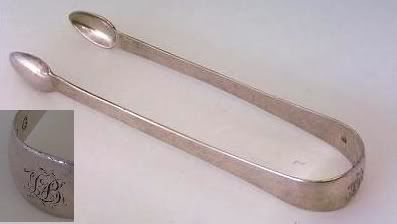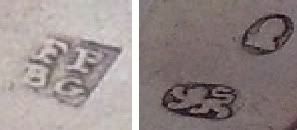Hi Clive and Miles,
I have a suspicion that it is not Francis Parsons, I could well be wrong, but if it is him, then he had a most curious history of partnerships.
As I understand it, FP was known to have been working from 1797-1831. Spoons with an ‘FP’ only mark have been attributed to him 1800-04, ‘FP over JG’ in 1804/5, ‘FP over BG’ in 1806-07 and ‘FP over SC’ 1797-1807 also ‘JG over FP’ 1811-13.
Shown below are two spoons which have the ‘FP over BG’ which I believe could be earlier than the earliest known working date for Parsons.

This style, Old English with shoulders, was popular in London circa 1770, and one would expect a natural delay for fashion to reach the provinces of maybe 15-20 years at the most, certainly they are post 1786 because of the Duty mark, but unlikely to be post 1797, the earliest date for Parsons.
Shown below are two slightly different spoons with the ‘JG over FP’ mark they are Hallmarked very similar to each other, and show the date of 1813 and are showing a full set of marks, less the Town Mark, at this date.

These might reflect a change of fortune for Parsons as he now appears to be the junior partner to Joseph Goss.
Which ever way one looks at it, it would appear that he had at least two separate partnerships running at the same time, with Joseph Goss and Stephen Crees.
So maybe there was an unknown ‘FP-BG’ partnership that ran c.1785-1807. If this was the case I can find no entries to back this up, but if correct it would make your tongs somewhat earlier than at first thought, maybe.
Of course another possibility is that ‘FP-BG’ were the fathers of ‘JG-FP’ with the sons taking over the business in c.1807, but that is just speculation on my part.
Another clue may be that of the Lion Passant. There appears to be three distinct varieties used during the earlier part of this period on smaller items.

I have yet to try and work out the sequence that they were used in.
Regards Trev.


